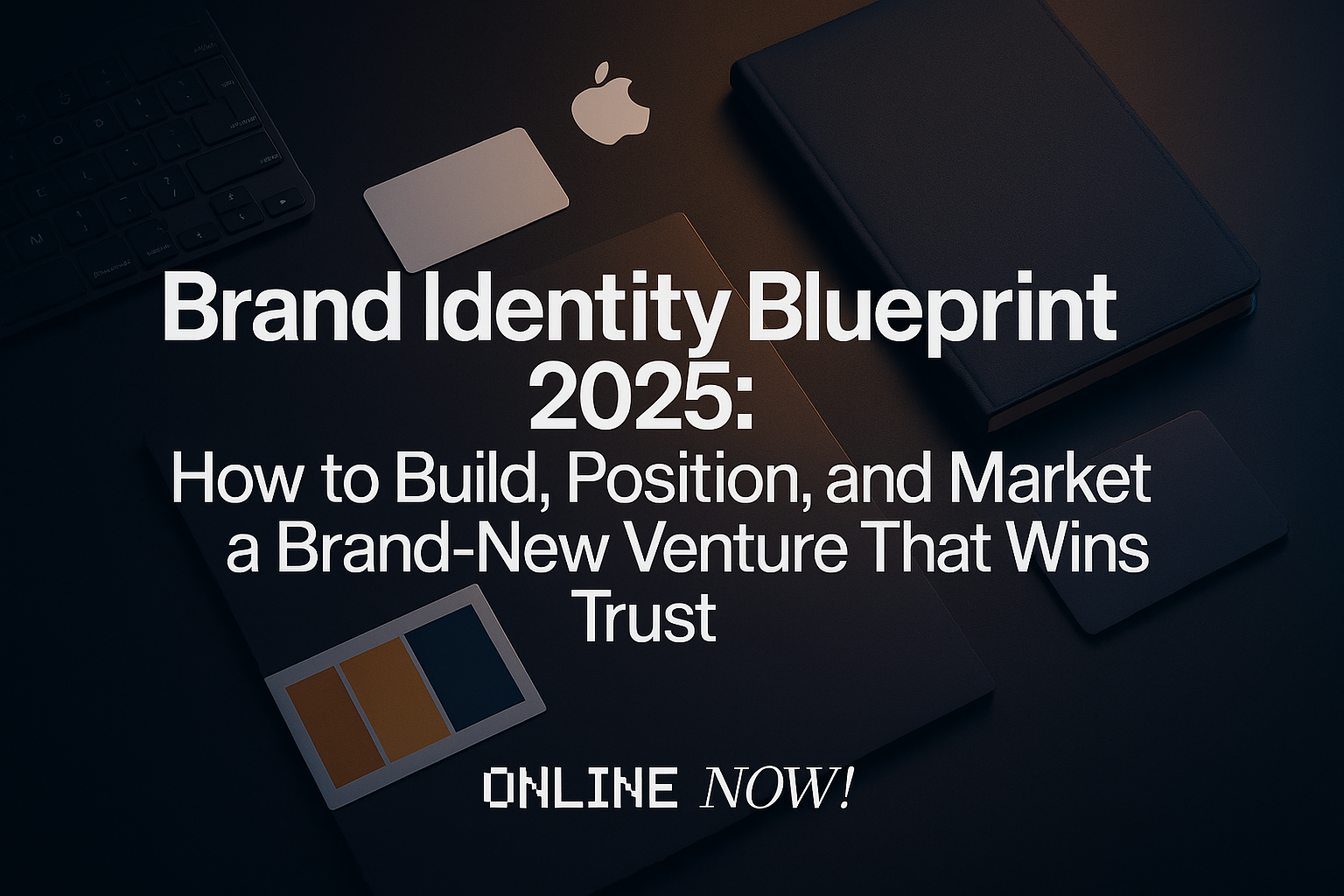Brand Identity Blueprint: How to Build, Position, and Market a Brand-New Venture That Wins Trust
Operational noise makes brand launches harder than ever—yet the brands that win do one thing consistently: they build trust through a clear, consistent identity system.
Brand identity isn’t a logo; it’s the coordinated system of strategy, language, and visuals that signals who you are, what you stand for, and why you’re different. This guide lays out a practical, end-to-end approach—strategy to execution—so your new venture shows up with intent from day one.
From Branding to an Identity System
Branding is the ongoing job of shaping perception. Identity is the toolset you use to do it: positioning, voice, messaging, mark, color, typography, imagery, and motion—working together across every touchpoint.
- Positioning & promise — the idea you want to own
- Voice & narrative — how you sound and what you say
- Visual system — logo/brandmark, color, type, grids, iconography
- Application rules — patterns for web, product, sales, and support
When these pieces are unified, every interaction feels intentional—and trust compounds.
Strategy to Positioning: Decide What You Stand For
Brand strategy aligns mission, vision, values, audience, and differentiation. Convert that strategy into positioning—the specific space you claim in the customer’s mind.
- Audience reality — problems, jobs-to-be-done, adoption barriers
- Competitive map — price vs. quality, utility vs. status, origin vs. innovation
- Positioning statement — “For [audience], [brand] is the [category] that [unique benefit], unlike [competitor] who [limitation].”
Everything downstream—naming, copy, palette, UI—should make that positioning obvious without explanation.
Designing the Visual Brandmark & System
Your brandmark translates positioning into something instantly recognizable.
- Mark types — wordmark, lettermark, pictorial/abstract, combination, emblem
- Color — choose a primary that supports your promise; use neutrals to scale
- Typography — 2–3 styles max (display, text, mono if needed)
- Layouts & grids — define rhythm for web, product, and print
- Motion rules — speed/curves that match personality
Principles: simple, legible at any size, flexible in dark/light, and documented in a style guide developers and marketers can actually use.
Amplifying Through Brand Marketing & Awareness
Identity earns its keep in market. Orchestrate channels by funnel stage and keep the voice consistent.
TOFU — Awareness
- Educational content, founder POV, influencer/editorial features
- Lightweight brand campaigns to seed distinctiveness
MOFU — Consideration
- Webinars/live demos, use-case pages, case briefs
- Email sequences that echo site voice and visuals
BOFU — Conversion & Loyalty
- Retargeting with proof (social proof, benchmarks)
- Referral and community programs that reinforce identity
Story pattern: customer = hero, problem = villain, your brand = guide, product = tool, success = clear outcome.
Measurement & Brand Equity
Track whether the system is working—and where to refine.
- Recall & preference — aided/unaided recall, first-choice rates
- NPS & satisfaction — by segment and lifecycle stage
- Share of voice — organic, paid, and social vs. peers
- Consistency — touchpoint audits against guidelines
Use findings to tune positioning, tighten voice, and simplify visuals—not add noise.
A Five-Step Framework to Launch Your Identity
| Step | Action | Key Outputs |
|---|---|---|
| 1 | Discover | Audience insights, competitive map, jobs-to-be-done |
| 2 | Define | Positioning, promise, narrative, voice pillars |
| 3 | Design | Brandmark, color/type, components, style guide |
| 4 | Deploy | Web/product UI, sales kit, social system, PR kit |
| 5 | Measure & evolve | Equity metrics, SOV, audit cadence, backlog of refinements |
Tools & Common Pitfalls
Working stack: design system (Figma), asset library/DAM, web components, copy manual, and an operating cadence for approvals.
Watch-outs:
- Pretty-first, strategy-later (reverse it)
- Inconsistent application across teams (appoint owners, enforce guidelines)
- Too many colors/fonts (reduce to essentials)
- Voice drift between channels (one narrative, adapted by stage)
Future Outlook: Adaptive, System-First Brands
Identity systems are becoming lighter, more modular, and more adaptive to channels and contexts. Brands that treat identity as a living product—versioned, measured, iterated—outlearn and outlast look-alike competitors.
Conclusion & Action Step
Strong identity is a growth tool, not a garnish. Align strategy, make the promise obvious, design a system people can recognize in a second, and measure what matters. Ship the v1, then improve it in public.
Want a fast start? See why your site still anchors the system here: why websites still matter.
Need a partner to move from strategy to shipped system? Book a 15-minute call and we’ll map your positioning, outline the identity system, and propose a launch plan.
